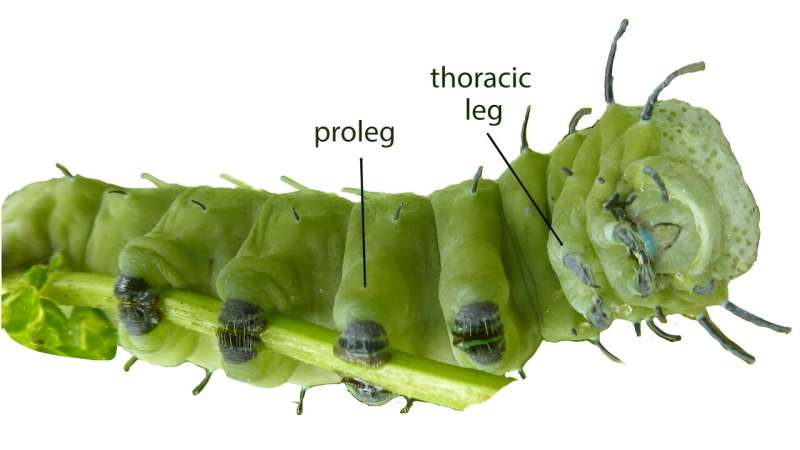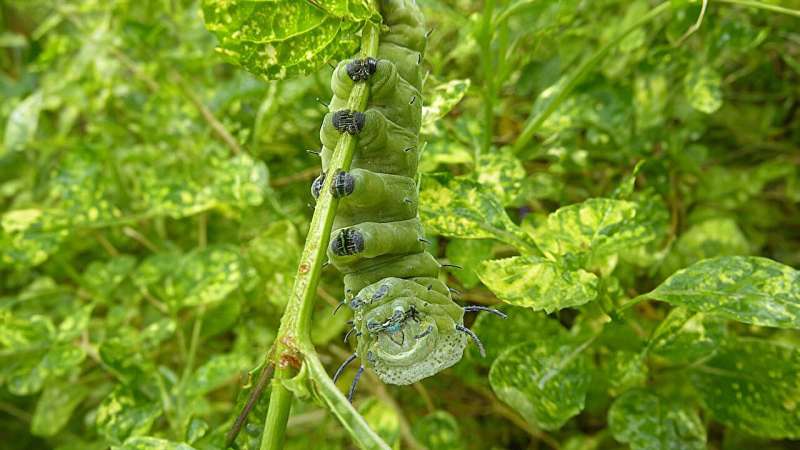This article has been reviewed according to Science X's editorial process and policies. Editors have highlighted the following attributes while ensuring the content's credibility:
fact-checked
peer-reviewed publication
trusted source
proofread
How do caterpillars acquire chubby legs? Scientists trace the origins to a genetic program associated with crabs

Adult insects, including butterflies and moths, typically have only three pairs of legs. But the existence of extra legs in caterpillars—chubby abdominal appendages also known as "prolegs"—has long posed an evolutionary mystery to biologists. A recent study by researchers from the National University of Singapore (NUS) linked this novel trait to crustaceans.
Caterpillars use their prolegs to grab on to twigs and leaves, while using their thoracic or 'true' legs to hold on to other plant parts for feeding.
"The three main theories regarding prolegs suggested that they might be modified thoracic legs, completely novel traits, or modified lobes (endites) of primitive thoracic legs," explained Professor Antónia Monteiro, who led the team of researchers from the Department of Biological Sciences at the NUS Faculty of Science.
"Our study proposes that prolegs are indeed novel traits unrelated to thoracic legs. However, they are derived from a genetic program that specifies lobes that were originally found in the proximal region of crustacean limbs, but had remained inactive in this limb region for millions of years."
The NUS team published their findings in the journal Science Advances.
Prolegs are not modified versions of thoracic legs
Lead author of the paper Dr. Yuji Matsuoka, who was formerly a Postdoctoral Research Fellow at NUS Department of Biological Sciences and now Assistant Professor at the National Institutes of Basic Biology in Japan, conducted experiments by disrupting a specific Hox gene, abdominal A, in various parts of the Bicyclus anynana butterfly larvae's abdomen, where the prolegs are located.
The complete disruption of the Hox gene resulted in the absence of prolegs, whereas partial disruption in only the most lateral parts led to the surprising development of two distinct traits in the abdomen—both prolegs and a modified version of thoracic legs. The results indicate that these two traits emerge from different locations in the body, and cannot be the same trait.

"The removal of prolegs through the disruption of this Hox gene indicated that the gene played an important role in initiating proleg development, whereas the appearance of modified thoracic legs, that are disguised as a type of secretory gland when the gene was disrupted, indicated that the Hox gene was repressing these traits," said Dr. Matsuoka. This means that two traits can potentially coexist in the abdomen of butterflies and moths: prolegs when the gene is active, and glands (modified thoracic legs) when the gene is inactive.
Dr. Suriya Murugesan, a Research Fellow at NUS Department of Biological Sciences, then conducted further analysis to determine the similarities between prolegs and other traits. He started isolating the genetic blueprint of various proteins, known as messenger RNAs (mRNAs), from various body appendages of caterpillars, including the horns, mouth parts, legs, and (larval) wings.
He discovered that the pool of mRNAs expressed in prolegs was quite distinct from thoracic legs and most similar to the pool found in head horns instead, which is another novel trait in butterflies and moths.
A trait more commonly associated with crustaceans
When the scientists examined the pool of genes that were uniquely expressed in prolegs, they discovered that some of these were known to be marker genes for endites. Endites are part of the appendages that are most commonly found today in the biramous, or two-branched, legs of crustaceans.
Although these endites are still found in the mouthparts of insects, including butterflies, their presence in prolegs highlights an intriguing evolutionary connection.
Prof Monteiro explained, "The evolution of the insect thoracic limb is quite complex. The Cambrian fossils indicate that limbs originated as appendages with a single axis of growth. Over time, these limbs became biramous and fused at their base. Subsequently, they developed internal-facing lobes close to the body wall, called endites."
"In some insect lineages, the thoracic limb reverted to a uniramous structure and lost these endites. The genetic program for these endites, which was never entirely erased from the genome, appears to have been reactivated again in the abdomen of caterpillars."
Prof Monteiro added, "This is an evolutionary story where limb complexity gradually develops during the Cambrian period. Some additions to the limb, such as these endites, evolved their own distinct genetic program."
"As evolution progressed and fresh water crustaceans transformed into land-dwelling insects, limbs became simplified, and these endite add-ons were removed from some body parts of insects but not others. In butterflies and moths, the endites got reactivated again to function as an entirely new type of limb in the abdomen, enabling the caterpillar to grasp and move on various surfaces."
Evolution is known for being economical, typically repurposing existing traits. In this case, prolegs are novel because they did not exist previously. However, they stem from pre-existing instructions for making bits of primitive legs, as previously theorized.
Now, it appears that the mystery of the many-legged caterpillar has been solved: an ancient genetic network, responsible for the same type of limbs found in crabs, has been re-activated after millions of years to produce the chubby legs of caterpillars.
More information: Yuji Matsuoka et al, Lepidopteran prolegs are novel traits, not leg homologs, Science Advances (2023). DOI: 10.1126/sciadv.add9389
Journal information: Science Advances
Provided by National University of Singapore





















